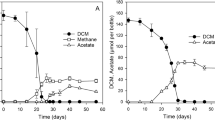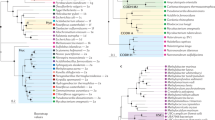Abstract
Globally, at least 5 Mt yr−1 of chloromethane (CH3Cl) must originate from natural sources, according to estimates based on environmental concentrations, man-made emissions of 26 kt yr−1 being insignificant in comparison1–3. Although CH3C1 is a natural product of several fungal species4,5, no quantitative investigations of its biological production have been reported. We have measured CH3C1 production by a common wood-rotting fungus, and report that on glucose-based media, the chloride ion (Cl−) at concentrations <4 mM was methylated with >90% efficiency. The pattern of CH3C1 biogenesis was typical of a secondary metabolite and paralleled loss of Cl− from the medium. With cellulosic substrates, CH3C1 yields ranged between 80 and 95% at Cl− concentrations as high as 25 mM, although production extended over a longer period. Bromo- and iodomethane were formed in high yield from the corresponding halide ions. Such high-efficiency methylation of the halide ion indicates that fungi could make a substantial contribution to the atmospheric CH3C1 burden.
This is a preview of subscription content, access via your institution
Access options
Subscribe to this journal
Receive 51 print issues and online access
$199.00 per year
only $3.90 per issue
Buy this article
- Purchase on Springer Link
- Instant access to full article PDF
Prices may be subject to local taxes which are calculated during checkout
Similar content being viewed by others
References
Lovelock, J. E. Nature 256, 193–194 (1975).
Singh, H. B., Salas, L. J., Shigeishi, H. & Scribner, E. Science 203, 899–903 (1979).
Edwards, P. R., Campbell, I. & Milne, G. S. Chemy Ind. 1982, 619–622 (1982).
Cowan, M. I. et al. Trans. Br. mycol. Soc. 60, 347–351 (1973).
Turner, E. M., Wright, M., Ward, T., Osborne, D. J. & Self, R. J. gen. Microbiol. 91, 167–176 (1975).
Weinberg, E. D. Adv. microb. Physiol. 4, 1–43 (1970).
Drew, S. W. & Wallis, D. A. in Secondary Metabolism and Differentiation in Fungi (eds Bennett, J. W. & Ciegler, A.) 35–51 (Dekker, New York, 1983).
Bethge, P. O. & Troeng, T. Svensk Papp-Tidn. 62, 598–601 (1959).
Long, C. in Biochemists' Handbook, 1040–1041 (E. & F. N. Spon Ltd, London, 1961).
Palmer, T. Y. Nature 263, 44–46 (1976).
Zafiriou, O. C. J. mar. Res. 33, 75–81 (1975).
Edwards, P. R., Campbell, I. & Milne, G. S. Chemy Ind. 1982, 574–578 (1982).
Neidleman, S. L. & Geigert, J. Biochem. Soc. Symp. 48, 39–52 (1983).
Harper, D. B. & Nelson, J. J. gen. Microbiol. 128, 1667–1678 (1982).
Author information
Authors and Affiliations
Rights and permissions
About this article
Cite this article
Harper, D. Halomethane from halide ion—a highly efficient fungal conversion of environmental significance. Nature 315, 55–57 (1985). https://doi.org/10.1038/315055a0
Received:
Accepted:
Issue Date:
DOI: https://doi.org/10.1038/315055a0
This article is cited by
-
The CH3F and CH3Cl detection by the BeO nanotube in the presence of environmental gases
Monatshefte für Chemie - Chemical Monthly (2022)
-
Design pollution gas sensor using graphene ribbon: density function theory (DFT)
Optical and Quantum Electronics (2022)
-
A comparison study of C19T (T = C, Cr, Ti, Fe, and Ni) nanocages by first-principle DFT calculation for removal of ozone-destroyer pollutants
Journal of Molecular Modeling (2020)
-
Biologische Halogenierung
BIOspektrum (2011)
Comments
By submitting a comment you agree to abide by our Terms and Community Guidelines. If you find something abusive or that does not comply with our terms or guidelines please flag it as inappropriate.



